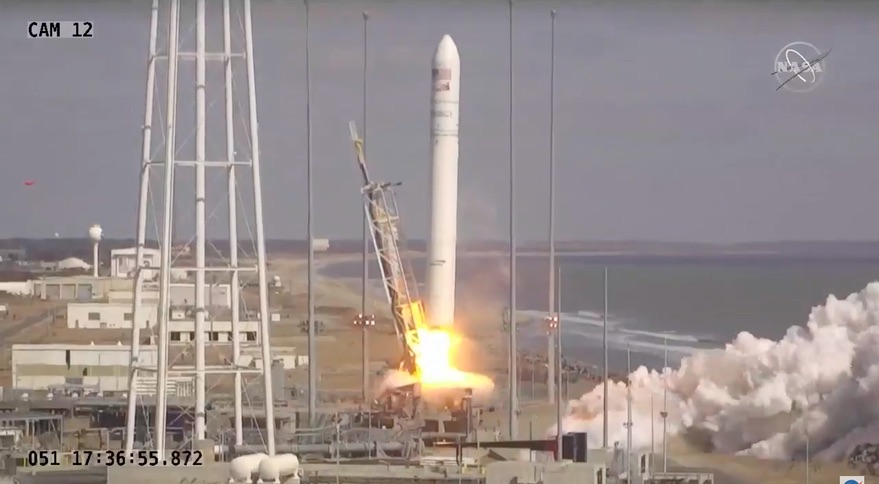Products You May Like
WASHINGTON — A Northrop Grumman Antares rocket launched a Cygnus spacecraft carrying supplies and experiments for the International Space Station Feb. 20.
The Antares 230+ rocket lifted off from the Mid-Atlantic Regional Spaceport at NASA’s Wallops Flight Facility in Virginia at 12:36 p.m. Eastern. The Cygnus spacecraft separated from the rocket’s upper stage nine minutes later.
The Cygnus spacecraft, flying a mission designated NG-15 by NASA, will arrive at the space station early Feb. 22, and will be berthed to the station by the Canadarm2 robotic arm. The Cygnus will remain at the station for about three months.
The spacecraft is carrying 3,810 kilograms of cargo, primarily crew supplies, science payloads and station hardware. That hardware includes equipment to support the station’s life support systems and spare parts for the station’s toilet, as well as an additional “alternate sleep accommodation” for the station now that there are regularly seven people on the station rather than the six that had been the standard for years.
As with past cargo missions, the NG-15 mission is carrying a diverse array of science experiments and supporting equipment, such as a Hewlett Packard Enterprise computer system designed to allow researchers to perform data analysis on the station rather than having to transmit the data to Earth. Other payloads include studies of artificial retinal implants, protein crystal growth, and a radiation sensor similar to one that will be flown on future Orion spacecraft.
The increase in crew size has translated into increased time for research, NASA officials said at a Feb. 19 prelaunch briefing. Joel Montalbano, NASA ISS program manager, said the agency was averaging about 35 hours per week of crew time devoted to research prior to the arrival of the Crew-1 mission, with four astronauts on board, in November. That has since more than doubled.
After departing the station, Cygnus will deploy several cubesats from two systems provided by Nanoracks and Spaceflight. Frank DeMauro, vice president and general manager of tactical space at Northrop, said the Cygnus could perform additional “experiments with the spacecraft itself” before it performs a destructive reentry.
The Cygnus spacecraft is named the S.S. Katherine Johnson by Northrop Grumman after the late Black mathematician who supported early NASA missions and was one of the central figures in the book and movie Hidden Figures. Johnson died last year at the age of 101. “She is an inspiration to so many people, especially women of color, and proved time and time again that racial barriers and glass ceilings are breakable, and shouldn’t have been there in the first place,” said DeMauro.
Upcoming ISS activities
The Cygnus will be the second cargo spacecraft to arrive at the ISS in less than a week. The Russian Progress MS-16 spacecraft, launched late Feb. 14, docked with the station in the early morning hours of Feb. 17.
NASA is planning to conduct two spacewalks from the station Feb. 28 and March 5. On the first spacewalk, NASA astronauts Kate Rubins and Victor Glover will perform work to prepare for installation later this year of new solar arrays. On the second, Rubins and JAXA astronaut Soichi Noguchi will carry out several maintenance tasks outside the station.
The station will then prepare for the arrival of three spacecraft currently scheduled for the month of April. NASA and Boeing plan to launch the CST-100 Starliner on a second uncrewed test flight no earlier than April 2. To prepare for that mission, Montalbano said the Crew-1 astronauts will relocate their Crew Dragon spacecraft from its current docking port to an alternate one in the latter half of March, freeing up its original docking port for the Starliner.
The Soyuz MS-18 spacecraft is set to launch to the station April 10. NASA announced Feb. 9 that it’s proposing to fly a NASA astronaut on that mission, which is currently scheduled to fly three Roscosmos cosmonauts, filing a procurement solicitation about its intent to do so through “in-kind” services rather than a cash payment.
Montalbano said at the briefing that there were no updates to those plans because the procurement solicitation was still open. That request for sources sought closed later Feb. 19, and he anticipated that afterwards “we’ll have the information and be ready to take the next steps.”
The SpaceX Crew-2 commercial crew mission is set to launch no earlier than April 20, transporting astronauts from NASA, ESA and JAXA to the station, allowing the Crew-1 mission to return to Earth in late April or early May. Montalbano said that NASA is in discussions with SpaceX about the failed Falcon 9 booster landing on its Feb. 15 launch to see if it involves any issues that could pose safety issues for that Crew-2 mission.
“We have an agreement with SpaceX to talk about any anomalies on any missions,” he said. “As of today, we’re working with them to better understand what happened, and right now it’s just too early to say if we’re going to have any impacts” on the Crew-2 mission.
